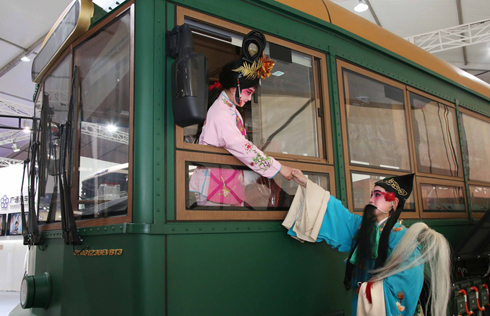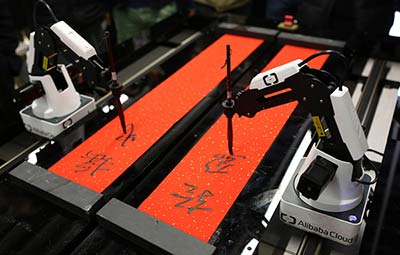Belt and Road Initiative strives to reflect 'globalization 2.0'
BOAO, China — China's Belt and Road Initiative is doing a key job in restructuring the global production value chain amid profound changes in the post-crisis world, agreed government and business leaders attending an forum here for promoting cooperation across Asia.
Traditional international investment and trade structure is undergoing a readjustment, they said during the annual conference of the Boao Forum for Asia held in south China's Hainan province.
Dwindling investment from the developed world and the rich countries' focus on rebooting their own manufacturing industry will result in sluggish trade and production around the world.
Pessimists are talking about the end of globalization. However, scholars are pointing to a new type of globalization that will be driven more by the East than the West.
Enhanced inter-connectivity, better cooperation
"Opening-up" has been a catch phrase by Chinese officials for quite a few decades. While sticking to its pledge for common development and shared prosperity with the rest of the world, China is pressing ahead with its supply-side structural reform.
The painstaking job promises to optimize China's growth mode and economic structure, enabling it to turn out better products and services for cooperative partners along the ancient trade routes, analysts said.
More than 30 years of opening up and rapid development since China adopted the policy of reform and opening to the outside world in 1978 have lifted China into the status of the world's second largest economy, Dong Wenbiao, chairman of China Minsheng Investment Group, told a special session on the Belt and Road Initiative in Boao.
It is transforming from a manufacturing powerhouse to a country stressing more on high-tech-led progress, said Dong, adding that "We hope to share our experience with the rest of the world, and the Belt and Road Initiative is a pilot project of such endeavors."
Proposed in 2013 by Chinese President Xi Jinping, the Belt and Road Initiative comprises the Silk Road Economic Belt and the 21st Century Maritime Silk Road, and is aimed at building a trade and infrastructure network connecting Asia with Europe and Africa along the ancient trade routes.
The initiative has so far gained the support of over 100 countries and international organizations, and more than 40 of them have signed cooperation agreements with China.
According to Dong, Chinese investors attach great importance to training of local people, especially in less developed regions, in realization of the Belt and Road Initiative. The trainees include not only senior managers, but also technicians and other workers.
"The Belt and Road Initiative is a very encouraging vision. Companies in Singapore welcome this initiative and they are very ready to help realize this vision," said Ann Sim, senior minister of the State of Singapore.
Sim said she can not think of a better example than the third government-to-government project between China and Singapore, or the Chongqing Connectivity Initiative (CCI), as a demonstration project within the framework of this initiative.
The CCI, after the launch of two government-led projects, the Suzhou Industrial Park in 1994 and the Tianjin Eco-City 2008 respectively, has demonstrated Singapore's support and dedication to the Belt and Road Initiative. It enhances the link between Chongqing and the rest of China, and with Southeast Asia in terms of transportation, finance and development of high technology.
"A strong connectivity is important for any country that is open to free trade," she said.
Portuguese Economy Minister Manuel Caldeira Cabral said his country is not only interested in Chinese investment in the energy and financial sectors, but also believes this investment has opened a door for China to reach deeper into Europe.
"Considering the special status and geographical position of Portugal, Chinese investment here also creates a platform for bringing the Belt and Road Initiative into Latin America and Africa," the minister was upbeat when talking about the strategy during the Boao forum.
Globalization 2.0
The type of globalization is changing largely because of the rise of China and the "globalization 2.0" is more about investment, infrastructure and development rather than just trade in the old times, said Amitav Acharya, writer of the popular book "The End of American World Order" in a recent interview with Xinhua.
Acharya said that China's biggest push to globalization is construction of infrastructure. He invited attentions to the Belt and Road Initiative with the aim of building a trade and infrastructure network connecting Asia with Europe and Africa along ancient trade routes.
With an eye for a more inclusive, mutually beneficial and equitable globalization, China has invested $18.5 billion in 56 economic and trade zones in countries along the routes.
The huge input has generated $1.1 billion of tax and 180,000 jobs in host countries, Chinese Commerce Minister Zhong Shan said earlier this month.
"The Belt and Road Initiative is against narrow-minded protectionism and isolationism," said Sergei Luzyanin, director of the Far Eastern Studies Institute under the Russian Academy of Sciences. "We only had the Western European-American option of integration and economic development in the 1990s, now there is a new option from China."
Investments and advanced technologies from China will push for a gradual formation of the "Silk Road value chain," analysts said.
The large presence of Chinese companies, especially those with special advantages in high-speed railway construction, and nuclear power and communication engineering, will boost the industrialization and urbanization of the countries on routes of the initiative, they said.























